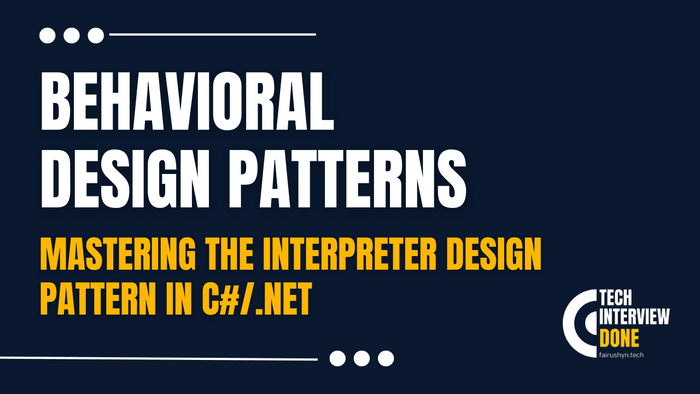Mastering the Interpreter Design Pattern in C#/.NET
3 min read · — #design-patterns#structrural-patterns#interpreter
Introduction
In the realm of software engineering, design patterns are the cornerstone upon which reliable, scalable, and maintainable applications are built. Among these, the Behavioral Design Patterns stand out for their ability to efficiently manage communication and the assignment of responsibilities between objects, paving the way for more organized and flexible code. Today, we delve into a particularly intriguing pattern: the Interpreter. This pattern, often shrouded in mystery and overlooked in favor of its more commonly applied counterparts, holds the key to unlocking a level of control and extendability in parsing and evaluating language grammars that is unparalleled.
The Interpreter pattern shines in scenarios where there is a need to implement a specialized language. This could range from adding scripting capabilities to your application, to parsing complex configuration files, or even to evaluating mathematical expressions or commands within a domain-specific language (DSL). By providing a framework to evaluate sentences in a language, it empowers developers to extend their applications in ways that are both sophisticated and maintainable.
Let's embark on a journey to unravel the mysteries of the Interpreter pattern, exploring its structure, implementing it in C#/.NET, and showcasing its real-world applicability through illustrative examples. By the end of this post, you'll not only grasp the fundamentals of the Interpreter pattern but also learn how to wield its power to enhance your applications.
The Interpreter Pattern: Structure and Implementation
The Interpreter pattern involves representing an idea or a task as an object, known as an expression, which can be interpreted. Its classic implementation typically follows these steps:
- Abstract Expression: An interface or abstract class defining the method
Interpretfor interpreting the context. - Terminal Expression: Implements the
Abstract Expression, interpreting parts of the sentence that do not need further decomposition. - Nonterminal Expression: Also implements the
Abstract Expression, interpreting parts of the sentence that require further decomposition or composition of terminal expressions. - Context: Contains information that's global to the interpreter.
- Client: Builds (or is provided with) the abstract syntax tree, represented by the
Abstract Expressionand its implementations. The tree is then traversed and interpreted.
Real-World Example: A Simple Mathematical Expression Evaluator
Consider you're building an application that requires the evaluation of simple mathematical expressions like "5 9 2 - +", which translates to "5 + (9 - 2)". Here's how we can apply the Interpreter pattern to solve this problem in C#:
Step 1: Define the Abstract Expression
public interface IExpression
{
int Interpret();
}Step 2: Implement the Terminal Expression
For our example, numbers are terminal expressions:
public class NumberExpression : IExpression
{
private int _number;
public NumberExpression(int number)
{
_number = number;
}
public int Interpret()
{
return _number;
}
}Step 3: Implement the Nonterminal Expressions
We'll have expressions for addition and subtraction:
public class AddExpression : IExpression
{
private IExpression _leftExpression;
private IExpression _rightExpression;
public AddExpression(IExpression left, IExpression right)
{
_leftExpression = left;
_rightExpression = right;
}
public int Interpret()
{
return _leftExpression.Interpret() + _rightExpression.Interpret();
}
}
public class SubtractExpression : IExpression
{
private IExpression _leftExpression;
private IExpression _rightExpression;
public SubtractExpression(IExpression left, IExpression right)
{
_leftExpression = left;
_rightExpression = right;
}
public int Interpret()
{
return _leftExpression.Interpret() - _rightExpression.Interpret();
}
}Step 4 & 5: The Context and the Client
In this simple example, the context is implicitly handled by the expressions themselves, and the client would build the
abstract syntax tree based on the expression to be evaluated. Parsing the expression and creating the tree is a complex
topic that involves tokenizing the input string and applying the appropriate grammar rules. However, once the tree is
built, evaluating the expression is as simple as calling Interpret() on the root of the tree.
Conclusion and Real-World Applicability
The Interpreter pattern offers a structured and scalable approach to parsing and evaluating language grammars. While the example provided here is intentionally simplistic, the pattern can be extended to support more complex grammars and scenarios, such as scripting engines, rule engines, or even custom query languages within your applications. Its power lies in its ability to separate the grammar rules from the interpreter logic, making both easier to understand and extend.
Next time you're faced with the challenge of interpreting complex expressions or implementing a domain-specific language, consider the Interpreter pattern. With its help, you can add a layer of
flexibility and power to your application that is both elegant and maintainable.
